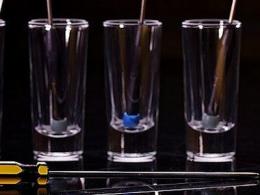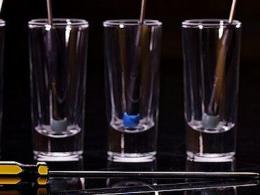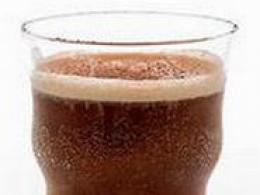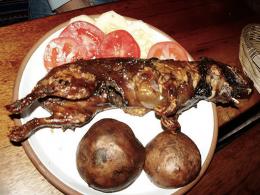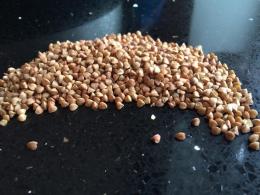The biological product lepidocid is the best protection of plants from pests. Preparations for combating pests and plant diseases How to prepare a 1% solution of lepidocid
If the number of fruit crops decorating a modern garden can be counted on the fingers of two hands, then their pests are already over a dozen. Moreover, each berry is attacked by 5-8 insects, ranging from camouflage moths to night moths. What can we say about a silkworm that turns a productive plantation into a living hell in a matter of days. Hence, the relevance of using universal insecticides increases by default. The biological product lepidocid, the use of which meets the main requirement, is worthy of a settlement in the first-aid kit of every gardener, gardener and even flower grower. This is because Lepidoptera creatures harm not only trees.
Description
Lepidocid was developed on the basis of soil bacteria, which, when it enters the intestines of an insect, causes a pathogenic reaction to delta-endotoxin: in the first hours after the meal, the pest experiences nausea, after which it becomes paralyzed and dies over the next 3-7 days.
How does the biological product Lepidocide work?
Lepidocide is a biological product with a high level of safety, therefore they are allowed to process even fruit-bearing plantations, provided that the crop is eaten no earlier than 5 days from the date of processing.
- On a note!
Today, pesticides and insecticides are commonly used to control insects. If the former belong to pesticides, then the latter offer a biological way to get rid of pests - the use of the so-called. pyrethrins and pyrethroids. The main advantage of the corresponding subgroup of insecticides is the absence of toxicity. Therefore, they do not cause burns in plants and poisoning in animals, as well as beneficial insects (ants, bees)
Lepidocid finds its application mainly in the fight against lepidoptera insects. In particular, we are talking about the following pests:
- Belyanka;
- Hawthorn;
- Goldentail;
- Leaflet nail;
- Moth;
- scoop;
- gooseberry fire;
- moth;
- Silkworm.
However, this does not prevent the use of a topical preparation against other aboveground eaters such as the Colorado potato beetle, wireworm, slugs, 
So that the agronomist can choose the most convenient treatment option, the Lepidocide release form provides for powder and suspension options. At the same time, the biological product is packaged in different materials:
- 20-50 liter canisters;
- 10-20 kg multilayer packages;
- 5-50 gram packages.
Large containers and packages are designed to store a concentrated suspension, bags - to store the powder. Accordingly, Lepidocide can be used to treat both small plantations and huge plantations.
"Important! Lepidocide has a limited shelf life, so it must be used immediately after purchase”
Video "Biopreparation Lepidocid"
Instructions for use
Processing of fruit crops with the Lepidocid biological product is carried out by spraying. The optimal concentration of the solution is 20 g/ml per 10 liters of water. In order for the insecticide to better adhere to the foliage, it is recommended to add 2 tablespoons to the solution of the appropriate volume. dry milk.
"On a note! Digestion of insects cannot absorb lactose, which is rich in the composition of any dairy product. Therefore, the addition of powdered milk to the topical solution not only contributes to the quality adhesion of the latter to the surface of the “tops”, but also accelerates the poisoning of the pest”
Applications of the biopreparation Lepidocid should be carried out in the morning or in the evening, when the sun minimally ashes the plants with its rays, accelerating their metabolism, due to which the biopreparation instantly evaporates. In addition, the beginning of the meal of caterpillars and bloodworms, respectively, falls on the morning and evening hours. The weather must be dry and clear, because. precipitation washes away Lepidocide.
Almost all pests are fertile, their egg-laying can be stretched for a month, or even for the whole season. This requires multiple treatments at intervals of 7-20 days. Below we provide a table that helps to understand the frequency of spraying with Lepidocide, depending on the crop:
Table "Use of the biological product Lepidocid"
Like any high-quality drug for pests, Lepidocid managed to gather a lot of positive reviews around him. Moreover, among grateful people there are both practicing gardeners and gardeners with experience.
Thanks to biological insecticides, including Lepidocide, the fight against the main pests of horticultural and vegetable crops has reached a new level. Now you can spray your favorite beds and plantings regardless of their vegetation, because the topical preparation does not impair the quality of the crop.
Lepidocid is produced on the basis of the Bacillus thuringiensis var. kurstaki.
The composition of Lepidocide includes the following components:
- spores and cells of the culture-producer Bacillus thuringiensis var. kurstaki;
- delta-endotoxin in the form of protein crystals;
- inert fillers that ensure the safety and stability of the drug.
Mechanism of action:
Lepidocid has an intestinal effect, i.e. manifests its activity only after entering the intestines of the insect. The active basis of Lepidocide is delta-endotoxin, presented in the preparation in the form of inactive protein crystals. Activation of delta-endotoxin occurs directly in the intestines of insects. Lepidoptera are characterized by alkaline pH contents of the midgut (pH 9.5-10.5). In an alkaline environment, protein crystals dissolve; protoxins are activated by intestinal proteolytic enzymes to "true toxins", which damage the inner lining of the caterpillar's intestines. The alkaline contents of the intestine enter the body of the caterpillar, causing septicemia. Insects stop feeding within the first 4 hours after drug treatment, stop moving and die en masse within 3-7 days.
Grain protection system:
Lepidocide is recommended for the protection of crops from the gray armyworm. Spraying is carried out during the growing season when the number of pests is not more than 20 individuals per 100 ears. Dosage of Lepidocide 1 l/ha. The flow rate of the working fluid is 200-400 l/ha.
Vegetable crop protection system:
To protect vegetable crops from caterpillars of lepidoptera insects (cabbage and turnip whitefish, moths, etc.), it is recommended to spray with Lepidocide at a rate of 0.5-1.0 l (kg) / ha against each generation of pests with an interval of 7-8 days. The flow rate of the working fluid is 200-400 l/ha.
Lepidocid is effective for protecting crops of sugar beets, carrots, cabbage from meadow moth caterpillars. The application rate of Lepidocide is 1.0 l (kg)/ha.
The system of protection of fruit crops and vineyards:
Lepidocid is recommended to be included in integrated systems for the protection of fruit crops after the cessation of chemical treatments to preserve the crop. Lepidocid is effective against 1-3 age caterpillars of apple and fruit moths, American white butterflies, moths, leafworms, silkworms. Spraying is carried out during the growing season against each generation of the pest with an interval of 7-8 days. Application rate of Lepidocide is 1 l (kg)/ha. Against codling moth caterpillars, Lepidocid is used at a rate of 2-3 l (kg)/ha.
In the vineyard protection system, Lepidocide is effective against caterpillars of the grape leafworm. The application rate is 2-3 l (kg) / ha.
Forest protection system:
Lepidocide is used to protect dark coniferous forests from Siberian silkworm and fir moth, oak forests - from gypsy moth and green oak leafworm; to control caterpillars (larvae) of other Lepidoptera insects. The application rate of Lepidocide is 3 l/ha. One processing carried out in a timely manner is considered sufficient.
Especially for use in the practice of forest protection, two forms of Lepidocide suspension concentrate have been developed: Lepidocide SK for large-scale aerial forest processing by low-volume (MO) and ultra-low-volume (ULV) spraying and Lepidocide SK-M for aerosol application using controlled dispersion generators.
The modern drug Lepidocid refers to biological agents, the action of which is aimed at combating various pests. The insecticide has a wide range of applications, thanks to which it helps to protect various fruit trees, shrubs and vegetable crops from the invasion of lepidoptera insects. Timely spraying of plants with Lepidocide allows you to get a quality crop.
The main characteristic of the insecticide
The composition of the insecticide includes special crystals, biological substances and microbial spores. In the modern world, this tool is actively used in the forest area, in the household, in household plots, as well as for spraying urban plantings.
When the drug enters the body of the pest, within four hours it completely paralyzes the function of the gastrointestinal tract, and after 24 hours it affects the entire body. As a result of this, the insect cannot move and eat, the color of its body changes, it wrinkles. Complete death occurs after 7 days.
Experts say that the maximum dose of insecticide can reduce the total number of new generations of pests. The main feature of the drug is represented by a pungent odor, which helps to scare away butterflies, thereby reducing the total number of eggs laid. In addition, Lepidocide does not accumulate in the fruits and leaves of plants, it is also not considered phytotoxic. Due to this, farmers, summer residents and gardeners will receive a high-quality and environmentally friendly harvest. The insecticide is completely safe for human health, warm-blooded animals, bees and fish.
Effective pest control
 To date, manufacturers produce various pesticides and insecticides to protect plants from pests. If the former belong to pesticides, then the latter fall into the biological group in which pyrethroids and pyrethrins are involved.
To date, manufacturers produce various pesticides and insecticides to protect plants from pests. If the former belong to pesticides, then the latter fall into the biological group in which pyrethroids and pyrethrins are involved.
The main advantage of Lepidocide is no toxic components. Thanks to this, plants are not susceptible to burns.
Experienced farmers and gardeners use insecticide for effective control with lepidoptera. The drug is especially effective in relation to such pests as:
- hawthorn;
- mole;
- whitefish;
- goldtail;
- scoop;
- nail leaflet;
- moth;
- gooseberry moth;
- codling moth;
- silkworm.
Manufacturers of the drug claim that it can be used to combat common aboveground devourers: wireworm, Colorado potato beetle, aphids and slugs. For a more economical use of the insecticide, manufacturers produce a powder and suspension version of Lepidocide. The tool itself is packaged in different containers:
- canisters of 20 and 50 liters;
- small packages of 5 and 50 grams;
- multilayer packages of 10 and 20 kg.
Large packages and containers are designed to store a universal concentrated suspension, but bags are for powder. Due to this, both small plantings and huge plantations can be treated with an insecticide.
Advantages and disadvantages of using
Like any other insecticide, this drug has its advantages and disadvantages. All of them must be taken into account for high-quality processing of crops.
The main advantages of the drug:

In addition to the numerous advantages of this tool, there are also disadvantages of using it, which should be considered before spraying.
Main disadvantages:
- under the influence of direct sunlight, the protective properties can be significantly reduced, so spraying is best done in the morning or evening;
- the insecticide does not have the ability to stick to the foliage, so you need to use special adhesives, thanks to which you can improve the quality of the treatments;
- the finished working solution cannot be stored until the next spraying;
- the drug is not particularly economical in use.
Instructions for use of the drug
 The working solution for spraying plants can only be prepared on the day of treatment in strict accordance with the dosage norms. Before use, the drug must be shaken. The required rate of insecticide is thoroughly dissolved in clean water, the temperature of which can vary from +15 °C to +20 °C.
The working solution for spraying plants can only be prepared on the day of treatment in strict accordance with the dosage norms. Before use, the drug must be shaken. The required rate of insecticide is thoroughly dissolved in clean water, the temperature of which can vary from +15 °C to +20 °C.
Plants can be sprayed only in dry and calm weather. The phase of crop development does not matter: the flowering period, during pollination or before harvesting. The maximum effect can be achieved if spraying was carried out in the early stages of pest development. Re-treatment can be carried out no earlier than 6 days later. The last spraying is carried out 5 days before the harvest of the ripe crop.
In order to increase the effectiveness of Lepidocide and extend the duration of its effect, it is necessary to add special adhesive Liposam at the rate of 200 g of insecticide per 1 hectare. Its dissolution must be carried out separately in a small amount of warm water (1:1). The solution must be stirred until a homogeneous consistency.
Since the drug belongs to the biological group, the maximum effect from the treatment of plants achieved gradually. Initially, the pest is paralyzed, due to which it loses the ability to move and eat normally (the insect stops harming the plant). 3 days after spraying, ¾ of all insects die. Re-treatment can be carried out after 8 days. This time, more than 95% of pests will die.
Freshly prepared working solution must be applied immediately, since in a diluted state it retains its properties for 24 hours. It is forbidden to increase the maximum dosage, as this may adversely affect the condition of the plant. The optimum air temperature at the time of crop processing should not exceed +30 °C.
Fruit plants and vineyards
Experts say that it is better to spray crops with a biological agent after it has been treated with chemicals. In this case, farmers and summer residents will be able not only to save the plants, but also to increase the harvest. The effectiveness of Lepidocide is aimed at combating pests such as:

The flow rate of the solution in this case is 30 g of the drug per 10 liters of water.
Spraying vegetable crops
 Timely spraying of vegetable plants with an insecticide helps to get rid of common pests - moths, turnip whites, meadow moths. Solution rate: 30 g of Lepidocide is needed for 10 liters of water.
Timely spraying of vegetable plants with an insecticide helps to get rid of common pests - moths, turnip whites, meadow moths. Solution rate: 30 g of Lepidocide is needed for 10 liters of water.
The instructions for the use and processing of potato tubers say that this crop is best sprayed immediately before planting in open ground. For maximum effect, plants are treated 1 time in 8 days when there is a large invasion of pests.
Treatment of forest plantations

For these cases, manufacturers have released insecticide in professional packaging. In addition, today, production of two types of suspensions of a concentrated agent has been established, which are used for aerial processing of forests and stationary spraying with generators. The consumption rate of the drug is 3 liters per 1 ha. Under the condition of timely processing, one spraying can be dispensed with.
Grains and medicinal plants
 Spraying crops with an insecticide helps protect crops from the gray armyworm. Processing is best done during the growing season during the first three stages of caterpillar development (its body length does not exceed 12 mm). The dosage rate of the solution is 30 g per 10 liters of water.
Spraying crops with an insecticide helps protect crops from the gray armyworm. Processing is best done during the growing season during the first three stages of caterpillar development (its body length does not exceed 12 mm). The dosage rate of the solution is 30 g per 10 liters of water.
Spraying of medicinal plants is carried out in order to protect against pests such as:
- leaflet;
- mole;
- meadow moth;
- goldtail.
Processing is carried out during the period of a large invasion of pests. The preparation of the working solution is based on the calculation 25 g Lepidocide per bucket of water.
The mechanism of influence on pests
An active effect on insects begins immediately after using the drug and is most intense during the first 4 hours. Protein crystals and spores of bacteria penetrate the gastrointestinal tract of pests, causing their paralysis and death. The high efficiency of the insecticide is due to the fact that the release of protein crystals by bacteria occurs throughout the entire period of their life.
Compatibility of Lepidocide with other drugs
The insecticide has good compatibility with various biological agents and chemical pesticides. Due to this, it can be used in tank mixes, as well as to reduce the level of resistance of pests to chemical components.
It is important to note that when an uncontrolled growth of insects occurred on the cultures, Lepidocid's working solution a minimum of 15% chemical pesticide must be added.
Basic Precautions
To date, Lepidocid belongs to the IV class in terms of safety, due to which it is considered practically harmless to humans, bees and beneficial insects. When using an insecticide, certain safety measures must be observed:

Shelf life and reviews
Lepidocid can only be stored in a dry place where direct sunlight does not penetrate. The air temperature can vary from +5 ⁰ to +30 ⁰ C. The storage place must be hidden from children and animals. The shelf life of the insecticide is 1 year.
For many years I have been fond of floriculture, thanks to which I actively use the drug Lepidocid. With it, you can protect plants without chemical treatment. After the first spraying, all caterpillars disappear. In addition, I used Lepidocid to treat tomatoes and sweet peppers - I am very pleased with the result. The only negative is the pungent smell of the drug, which is why it cannot be used indoors.
For several years I have been using Lepidocid to treat garden plants, but for a better effect I add an adhesive to it. The very first spraying showed an excellent result in the fight against leafworm, which destroys currant and gooseberry bushes. The drug is effective, so I recommend it to gardeners and summer residents.
I used Lepidocide on my site to fight the moth and sawfly. Now I try not to miss the moment when insects are just appearing on plants. In my case, three sprays were enough with an interval of 10 days. The result pleased.
margarita
Attention, only TODAY!
Insect pests can cause significant damage to your crop. Therefore, the gardener needs to take care of protecting his garden from early spring. Far from each drug can cope with insects such as whiteflies, so it is very important to choose the best remedy even before spring flowering. Today we will tell you about the Lepidocide insecticide. Reviews of gardeners confirm that this is one of the best drugs in its class.
Short description
Chemistry in our garden plot is a familiar way to protect against various pests. But how safe is it? After all, the harvested fruits are often eaten even without heat treatment. There is no single answer today. In most cases, agricultural technicians agree that if the treatment is carried out on time, then the risk to your health will be minimal. At the same time, the garden is completely protected from pest attacks.
But science does not stand still, and today biological products are becoming increasingly popular, that is, agents whose action is based on living organisms, bacteria and viruses, or antagonist fungi. The biological insecticide Lepidocide deserves special attention. Reviews say that this tool allows you to deal with the most common pests. These are primarily caterpillars of lepidoptera insects. These are silkworms and leafworms, scoops and moths, cabbage.

The main advantages of the drug
Why do leading agricultural technicians recommend using Lepidocid? Reviews of experts say that the drug does not accumulate in fruits and is completely non-toxic, which is confirmed by the results of numerous studies. That is, it is one of the best modern means for combating garden pests. What is very convenient, it can be used in any phase of plant growth. This property is useful if processing needs to be done at a time when the fruits are already ripening. If you use it in the dosages indicated in the instructions, then it does not harm the environment, it is completely safe for humans and bees.
General characteristics
Let's take a closer look at what the Lepidocide insecticide is. Reviews allow us to conclude that farmers highly appreciate its effectiveness, and the reader is probably already very interested in how it is achieved. The drug is produced on the basis of a strain of Bacillus thuringiensis. That is, the composition of the product contains spores and cells of this culture, which work against the pests of your garden. Additionally, the composition contains protein crystals and inert fillers, which are designed to maintain the stability and safety of the active ingredients.
In specialized stores you can find two forms of the drug "Lepidocid". Instructions for use (we will give reviews a little lower) says that you can use a suspension concentrate or powder.

Features of the drug
It is sprayed directly on garden plantings and fruit trees. What do experienced gardeners say about Lepidocid? Reviews emphasize its complete safety, which is extremely important when processing berry crops that children love to feast on.
The drug has an intestinal effect, that is, it is active only when it enters the stomach of an insect. This is both an advantage and a disadvantage. On the one hand, the active substance remains only on the surface of the plants and does not get into the fruits, but on the other hand, heavy rain will completely wash off the composition, and your plantings will again remain defenseless. But this disadvantage is compensated by the fact that during the summer season you can resort to the help of the Lepidocide drug an unlimited number of times. Instructions for use (reviews from the country's leading agricultural technicians confirm that you only need to monitor the activity of pests in the garden plot) suggests using this tool as soon as you notice an increase in their number.

Mechanism of influence
As we have already said, the drug contains not only a strain of bacteria, but also delta-endotoxin in the form of protein crystals. In the alkaline environment of the intestines of insects, they are activated and damage the inner shell. Pests stop eating and moving. If a lot of insects have chosen your garden, then you can watch how they stop moving and eating after 4 hours after treatment. For several days they sit motionless, after which they die.
Mode of application
Let's look at the general scheme of how the garden is processed. First of all, you need to choose the morning or evening hours, it is at this time that the procedure will be most effective. It is very good to process plantings during the mass appearance of pest caterpillars. However, this may be a problem if you plan to use Lepidocide against the Colorado potato beetle. Instructions for use recommends repeating the treatment at least three times, since the egg-laying of these pests is extended in time. If heavy rains fall, then the procedure should be performed at intervals of 6-8 days. In dry and clear weather, the interval is 15 days. There are some features of using an insecticide on each horticultural crop separately. We'll talk about this in a little more detail.

Grain Scoop
This is one of the most formidable pests. To protect plantings, you can use the drug "Lepidocid". For 100 liters of water, 1-2 liters of the drug are consumed. The working solution must be shaken well and placed in a spray bottle. Spraying occurs during the growing season. The flow rate of the working fluid is 200-400 l/g. Cutworms should be treated at least three times per season to ensure perfect protection.

vegetable crops
Very often Lepidocide is used against potato moths, as well as caterpillars of lepidoptera insects. These are cabbage and turnip whites, moths - terrible pests of the garden and vegetable garden that can leave you without a crop if you do not take action in time. Since several generations of pests may appear over the summer, a number of treatments are required. The consumption of the drug is small - only 0.5 liters per 100 liters of water. Each new generation of pests is born with an interval of 7-8 days, so it is recommended to repeat the treatment every week. The consumption of the working solution is 200-400 liters per hectare. This insecticide is very effective in protecting sugar beet, carrot and cabbage crops from caterpillars.
fruit crops
The most commonly used is Lepidocid against pear sucker and other garden pests. The first treatment, which is carried out before the flowering of the garden, can be carried out with chemicals. But the following procedures, necessary to preserve the crop, are best carried out with the Lepidocide biological product.
The treatment may be effective against apple and fruit moth caterpillars, American fruit moth, moths, leafworms and silkworms. Spraying is done every 7-8 days. This insecticide showed itself very well as part of the protection of vineyards from grape leafworm. Consumption rate - 2-3 l / ha.

Whitefly and thrips, the scourge of horticultural crops
Especially often these insects settle in closed greenhouses, and it is very difficult to get rid of them. Gardeners have already tried absolutely everything: they set fire to sulfur and sprayed Dichlorvos, but after a short time the insects attacked the plants again. Today, many already know that Lepidocide against the whitefly has shown itself very well, and besides, it is completely safe for people. In parallel, the insecticide perfectly destroys scale insects, thrips, weevils and other similar pests.
However, if the whitefly has chosen your garden, especially closed greenhouses and greenhouses, it will take a long time to fight it. The fact is that eggs in the ground can wait out an unfavorable period, and the new generation will begin to attack fruit plants with even greater zeal. Therefore, if you want to win, you need to process at weekly intervals throughout the summer season. Then next summer it will be possible to spray the trees only for preventive purposes.
Summing up
Complex insecticide "Lepidocid" is a real assistant to the modern gardener. It is active against most garden pests, but it does not accumulate in the soil and fruits, that is, it makes it possible to obtain environmentally friendly products. This preparation is well compatible with most of the chemicals that the garden has previously been treated with. Even a significant increase in air temperature does not lead to the decay of the insecticide. This is very true during the hot summer months. Poisoned insect species are not addictive, which means you can be calm about your plantings every year.


